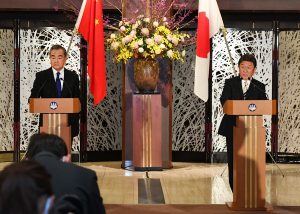Ahead of Japanese Prime Minister Suga Yoshihide’s first trip to Washington, D.C. – and after an inaugural 2+2 meeting with Biden administration officials in Tokyo – China’s Foreign Minister Wang Yi warned his Japanese counterpart not to be “misled by some countries holding biased view against China.”
“The two sides should cherish and safeguard the hard-won overall situation of improvement and development of China-Japan relations… and ensure that bilateral relations do not flip-flop, stagnate or backpedal, and do not get involved in the so-called confrontation between major countries.,” Wang told Japanese Foreign Minister Motegi Toshimitsu in a phone call on April 5, according to a read-out from China’s Foreign Ministry.
The call between Wang and Motegi was aimed at calibrating China-Japan relations in the midst of early outreach from the Biden administration in the United States. Beijing was alarmed by unusually stern language regarding China during foreign and defense minister talks in Tokyo in March, and wants to warn Japan against similar signaling during Suga’s visit to the United States, starting on April 16.
After a Japan-U.S. 2+2 meeting in Tokyo on March 16, the two countries’ foreign and defense minsters issued a joint statement that “acknowledged that China’s behavior, where inconsistent with the existing international order, presents political, economic, military, and technological challenges to the Alliance and to the international community.” The second paragraph of the statement was essentially a list of shared concerns about Chinese behavior, from “China’s unlawful maritime claims and activities in the South China Sea” to the need for “peace and stability in the Taiwan Strait” to human rights concerns in Xinjiang and Hong Kong.
As Yuki Tatsumi commented in an analysis for The Diplomat Magazine, “the degree of specificity with which the joint statement lays out the two countries’ concerns vis-à-vis China is unprecedented.” The inclusion of a reference to the Taiwan Strait in the statement was a particularly notable first, given Japan’s reluctance to mention Taiwan in the past.
China noticed, and it was not pleased. Foreign Ministry spokesperson Zhao Lijian aimed some of his usual bombast at Japan after the joint statement was released:
Japan, driven by the selfish aim to check China’s revitalization, willingly stoops to acting as a strategic vassal of the United States, going so far as to break faith, harm relations with China, invite the wolf into the house, and betray the collective interests of the whole region. Such despicable behavior is deeply unpopular.
“We urge the United States and Japan to immediately stop interfering in China’s internal affairs, stop forming the anti-China clique, and stop undermining regional peace and stability,” Zhao added.
Wang’s phone call, while more diplomatic in tone, conveyed a similar message: Beijing is unhappy with Tokyo’s new forward-leaning stance, in concert with the United States. “China hopes that Japan, as an independent country, will look at China’s development in an objective and rational way, instead of being misled by some countries holding biased view against China,” Wang said. He acknowledged Japan’s alliance with the United States, but pointed out that “China and Japan have also signed the Japan-China Treaty of Peace and Friendship, so Japan also has the obligation to fulfill the treaty.”
For his part, Motegi repeated the Japanese insistence that “the Japan-U.S. alliance does not target any specific third party.” He continued: “Japan attaches great importance to its relations with China and remains committed to ensuring the steady development of Japan-China relations.”
At stake is a fragile thaw in China-Japan relations that began under former Prime Minister Abe Shinzo. China-Japan relations were in a deep freeze throughout much of Abe’s nearly eight-year stint at prime minister, thanks to his flirtation with historical revisionism (including a controversial visit to Yasukuni Shrine in 2013). Yet even while Abe became a champion of the resurrected Quad and the Trans-Pacific Partnership – both seen in Beijing as “anti-China” – he simultaneously managed a tentative warming in relations with Beijing.
The process was supposed to culminate in Chinese President Xi Jinping’s first state visit to Japan in April 2020. But the trip was cancelled amid the COVID-19 pandemic – apparently with great reluctance on Tokyo’s part. The Japanese government was even accused of being slow to react to the pandemic out of fear of offending Xi before his planned visit.
Now the window for such a visit may have closed. Like much of the Western world, Japan’s mood on China soured greatly over the course of 2020, amid an increasing crackdown in Hong Kong and aggressive, even insulting rhetoric from China’s diplomats around the world. That led to calls from Japanese lawmakers to scrap any plans to host Xi, even as Beijing itself expressed displeasure with Japan’s pushback. Wang’s own visit to Tokyo in November 2020 sparked protests and criticisms from Japanese legislators – even some within Abe and Suga’s ruling Liberal Democratic Party.
Japanese media have reported that a visit from Xi is unlikely in 2021, while holding out hope for a trip in 2022. That year marks the 50th anniversary of the establishment of diplomatic relations between China and Japan. Whether there will be much cause for celebration next year, however, is uncertain.
































